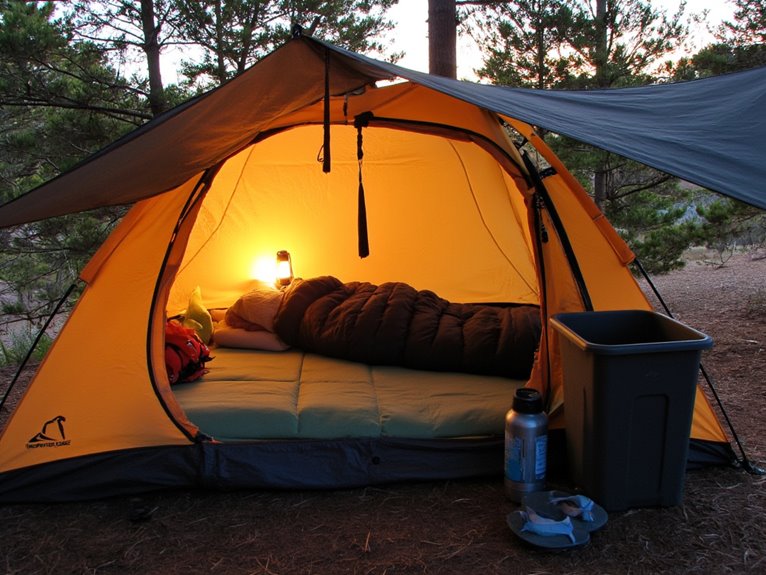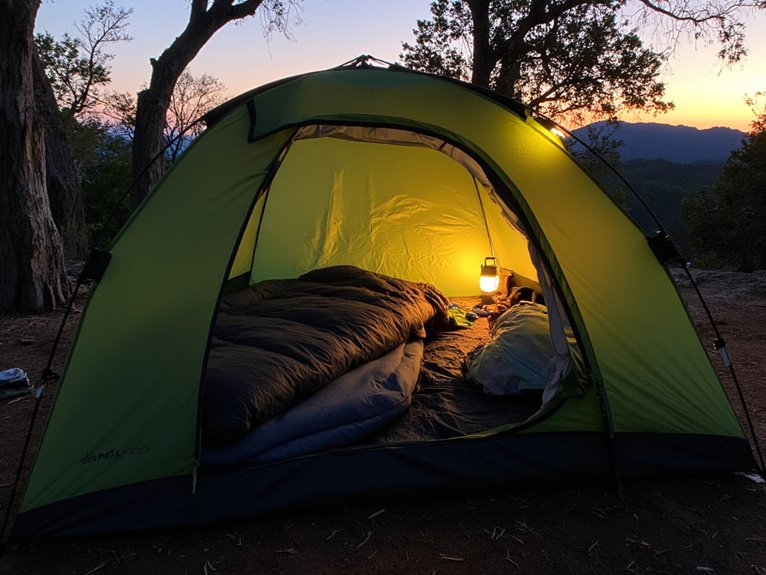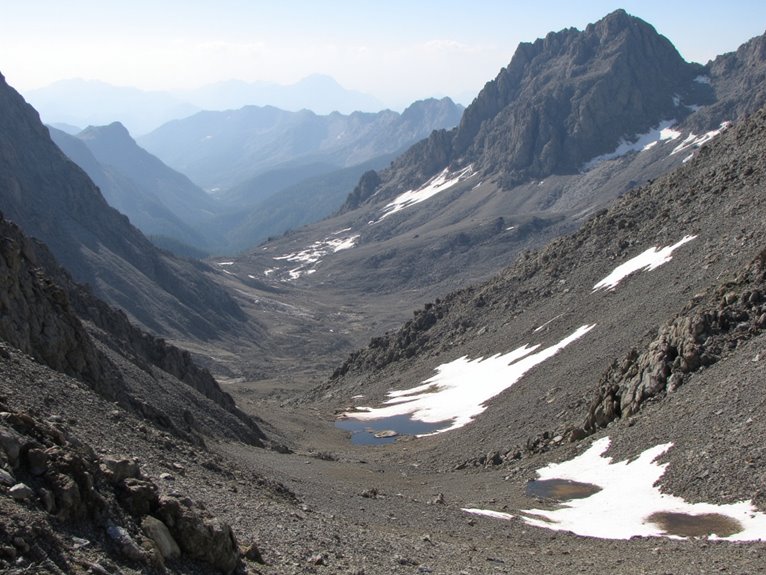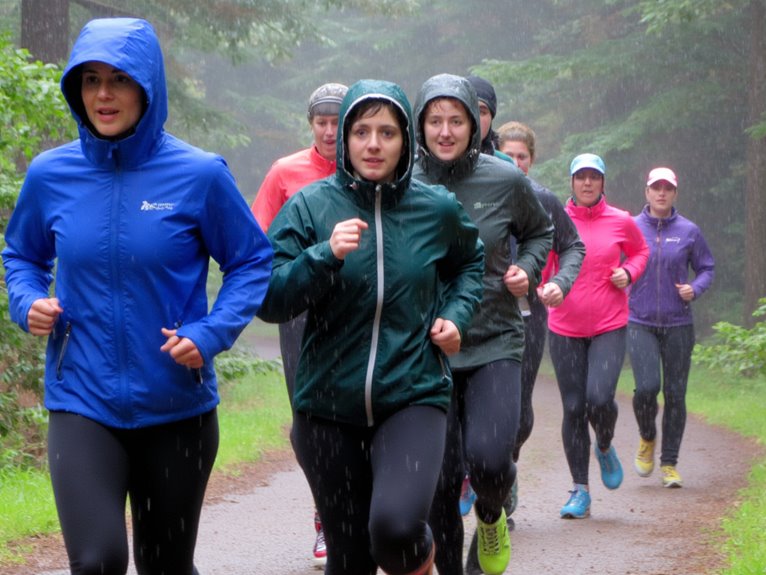How to Set Up and Maintain a Comfortable Sleep System at Camp
A comfortable camp sleep system requires three core components: a temperature-rated sleeping bag (650-900 fill power for down), an insulated sleeping pad with R-value above 4.0, and proper shelter setup with cross-ventilation. Position your tent away from prevailing winds, clear debris from the sleeping area, and deploy ground protection to prevent moisture infiltration. Maintain gear by air-drying after each use and storing uncompressed to preserve loft. Master these fundamentals to access advanced comfort optimization techniques.
We are supported by our audience. When you purchase through links on our site, we may earn an affiliate commission, at no extra cost for you. Learn more. Last update on 9th December 2025 / Images from Amazon Product Advertising API.
Notable Insights
- Choose a sleeping bag with appropriate temperature rating and pair with a sleeping pad having R-value above 4.0 for cold weather.
- Level your sleeping area by clearing debris, deploy ground protection, and position tent doors for cross-ventilation while avoiding prevailing winds.
- Manage moisture by opening opposing vents early evening and using breathable gear to prevent condensation that compromises insulation effectiveness.
- Air-dry all sleep gear completely after use, store sleeping bags uncompressed, and spot-clean with mild soap to maintain loft.
- Implement noise control by placing tents away from high-traffic areas and use LED lighting with dimmer switches for comfortable ambiance.
Essential Components of Your Camp Sleep System
When setting up camp for the night, your sleep system becomes the foundation of rest and recovery in the outdoors. Your system requires five essential components working together.
A sleeping bag provides primary insulation through down or synthetic materials. Fill power ratings of 650-900 determine warmth efficiency.
Your camping pillow offers critical neck support through ergonomic design.
Ground insulation comes from sleeping pads in three pad types: inflatable, self-inflating, or closed-cell foam. Each delivers different R-values for temperature protection.
Appropriate clothing layers regulate body temperature throughout the night. Additional bedding provides backup warmth when conditions deteriorate.
Weather resistance across all components guarantees performance in rain, snow, and wind. Insulation materials must maintain loft when compressed or wet to preserve thermal efficiency. Hybrid insulation combines the warmth-to-weight benefits of down with the moisture resistance of synthetic materials, retaining 80-90% loft in wet conditions.
Choosing and Setting Up Proper Shelter and Ground Protection
After establishing your sleep system components, selecting and positioning your shelter becomes the critical next step that determines your comfort and safety throughout the night.
Different shelter types offer distinct advantages depending on your hiking style and conditions. Freestanding tents remain most popular due to their versatility and quick setup. Trekking pole tents provide ultralight alternatives, while tarps and bivy sacks minimize weight further.
Choose your shelter based on hiking priorities: freestanding tents for versatility, trekking pole shelters for weight savings, tarps for minimalism.
Your setup strategies directly impact performance:
- Position doors for cross-ventilation while avoiding prevailing winds and potential water runoff paths
- Level your sleeping area by clearing debris and rocks that create pressure points
- Deploy ground protection using footprints or tarps to prevent moisture infiltration and extend tent floor life
Secure anchoring with proper guylines and stakes guarantees structural integrity during weather events.
Proper ventilation reduces condensation buildup that compromises insulation.
Ground contact compresses sleeping bag insulation and creates a thermal sink, making proper barrier protection beneath your sleeping system essential for maintaining warmth throughout the night.
Managing Insulation and Temperature Control
Your sleep system’s thermal performance depends on selecting gear with appropriate temperature ratings and managing airflow to prevent condensation buildup.
Temperature ratings indicate the lowest temperature at which your sleeping bag will keep you warm, but you’ll need to account for your personal cold tolerance and metabolic rate.
Proper ventilation control prevents moisture accumulation while maintaining your desired internal temperature through strategic adjustments to tent vents and sleeping bag zippers.
Women typically require sleeping bags rated 10-15 degrees warmer than standard ratings due to differences in metabolic heat production and cold tolerance.
Temperature Rating Selection
Selecting the right temperature rating for your sleeping bag determines whether you’ll sleep comfortably or shiver through the night.
Understanding temperature ratings prevents mismatched gear selection. EN and ISO ratings provide standardized metrics: Lower limit serves male sleepers while Comfort limit targets female sleepers.
Three critical factors guide your insulation selection:
- Camping season requirements – Summer bags rated 35°F+, three-season bags 15-35°F, winter bags below 15°F
- Personal thermal characteristics – Cold sleepers add 10-15°F buffer to manufacturer ratings
- Environmental conditions – Ground temperature, elevation, and weather patterns affect actual performance
Comfort ratings suit typical users.
Limit ratings work for experienced campers and warm sleepers.
Extreme ratings apply only during emergencies.
Your activity level before sleep and sleeping mat R-value directly impact thermal efficiency.
Ventilation and Moisture Control
Proper temperature ratings won’t matter if moisture compromises your insulation’s performance throughout the night. Understanding moisture sources helps you prevent condensation buildup that reduces thermal efficiency by up to 40%. Human breath releases approximately one pint of water vapor nightly, while wet gear stored inside adds significant humidity loads.
Effective ventilation techniques require opening opposing rainfly vents and tent windows to create cross-flow air exchange. Position your tent door facing gentle breezes for natural circulation. Keep rainfly and tent walls taut, creating a critical air gap between layers that prevents condensation transfer.
Open vents early evening before moisture accumulates rather than waiting until problems develop. Use breathable insulation layers and moisture-resistant sleeping pads to prevent ground condensation from penetrating your sleep system.
Cleaning and Maintaining Your Sleep Gear
Three fundamental maintenance practices will extend your sleep system’s lifespan by years while ensuring peak performance in the field.
Consistent maintenance routines transform basic camping gear into reliable long-term investments that perform flawlessly when conditions demand excellence.
Proper sleeping bag care and tent maintenance require systematic approaches that prevent premature deterioration.
Essential Sleep System Maintenance:
- Spot-clean with mild soap between trips using damp sponges, limiting full washing frequency that degrades insulation.
- Air-dry completely after each use by hanging gear in ventilated areas, preventing mold and mildew formation.
- Store uncompressed in breathable bags, maintaining loft integrity and preventing moisture accumulation.
Inspect gear regularly for punctures, broken zippers, or damaged waterproof coatings.
Use sleeping bag liners to minimize dirt transfer and extend cleaning intervals.
Never store damp equipment—moisture destroys insulation properties and creates bacterial growth.
Follow manufacturer specifications for cleaning agents, as harsh detergents compromise technical fabrics and DWR treatments.
When full washing becomes necessary, keep water temperature below 40°C (100°F) and use down-specific products for down-filled bags to prevent damage to the insulation.
Enhancing Comfort With Additional Accessories

Beyond your basic sleeping bag and pad, strategic accessories can transform an adequate sleep system into a genuinely comfortable one.
You’ll want to contemplate upgrading your pillow setup and mattress configuration to match your specific comfort needs and sleeping position preferences.
Additionally, controlling environmental factors like ambient light and camp noise will greatly impact your sleep quality throughout the night.
Modern ultralight inflatable pillows typically weigh between 3-6 ounces and compress to soda can size, making them essential additions that won’t burden your pack weight.
Pillow and Mattress Options
Comfort at camp hinges on selecting the right pillow and mattress combination for your specific needs and conditions. Consider these core options for ideal sleep quality:
- Self-inflating mattresses offer automatic inflation with built-in foam cores, eliminating manual pumping while providing consistent support.
- Air pads deliver ultralight solutions for backpacking at 1-2 pounds, though they require more setup time.
- Hybrid sleep systems combine self-inflating bases with air chambers for customizable firmness levels.
For pillow selection, integrated pillow attachments prevent nighttime shifting and maintain proper head positioning. Inflatable pillows pack down to baseball size while offering adjustable firmness through valve control.
R-values determine thermal performance—ratings above 4.0 provide adequate cold-weather insulation.
Thicker mattresses like 4-inch models offer superior comfort but increase pack weight. Match your system to trip duration and transportation method.
Lighting and Noise Control
While sleep comfort depends heavily on mattress and pillow selection, proper lighting and noise control transform your campsite into a true sanctuary for rest.
LED strips create ambient lighting under panels or inside tents, producing warm color temperatures that promote relaxation. Install dimmer switches to adjust brightness levels throughout the evening. Battery-powered and solar-powered options eliminate cable dependency while maintaining consistent illumination.
Sound absorbing materials like foam panels reduce external noise by 20-30 decibels. Strategic tent placement shields you from prevailing winds and road noise. Select campsites 100+ yards from high-traffic areas when possible.
Power stations provide reliable energy distribution for lighting systems. White noise devices mask disruptive sounds effectively. Camping curtains block external light sources while soundproofing tents offer additional noise reduction.
These modifications create controlled environments that facilitate deeper, uninterrupted sleep cycles.
Lightweight Solutions for Backpacking Adventures
When backpacking into remote wilderness areas, every ounce in your pack matters, making lightweight sleep systems essential for comfortable multi-day adventures.
Your gear selection directly impacts your hiking performance and comfort. Consider these three critical components for weight optimization:
- Pad Selection: Inflatable pads offer superior R-value importance with minimal weight, while foam pads provide durability. Hybrid pads combine both benefits for balanced performance.
- Ultralight Bags: Choose sleeping bags weighing 2-3 pounds with appropriate temperature ratings for your conditions.
- Essential Accessories: Include compression sacks for space efficiency and repair kits for emergency pad fixes.
Material selection affects warmth retention and longevity. Modern ultralight sleeping pads utilizing 40D ripstop nylon materials compress to the size of a water bottle while maintaining excellent durability.
Weight balancing between comfort and portability requires careful evaluation of each component’s necessity versus its carried weight impact.





